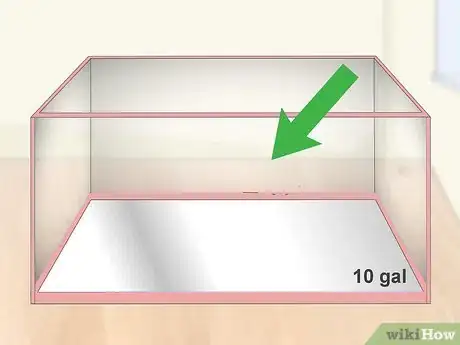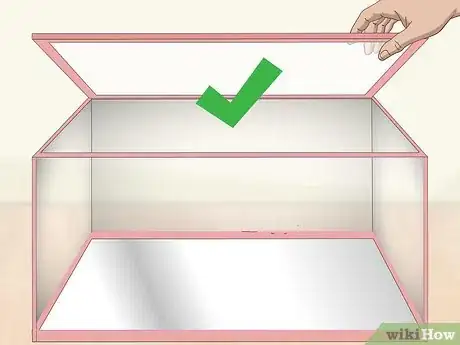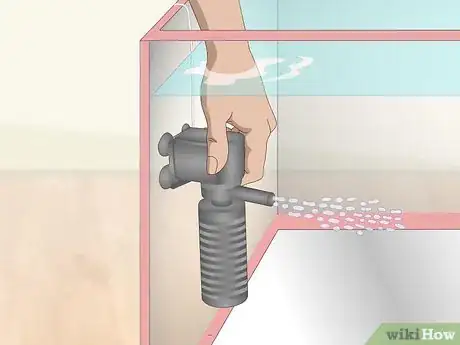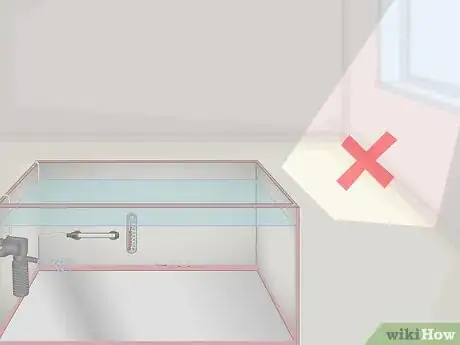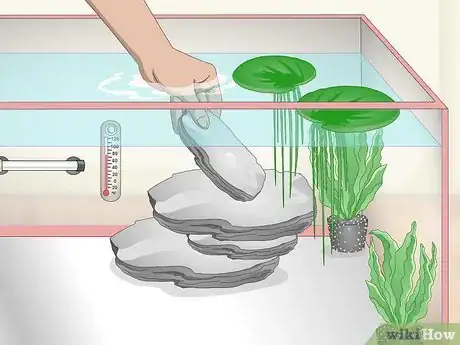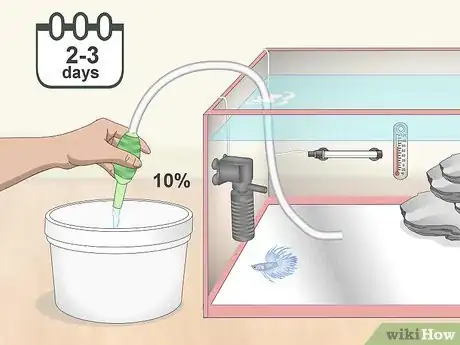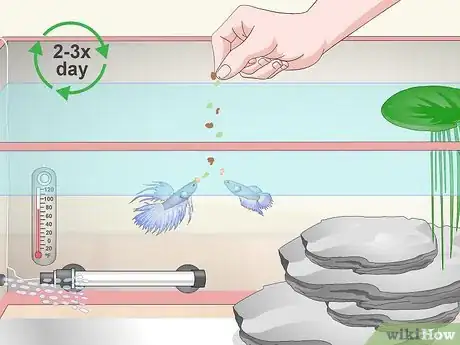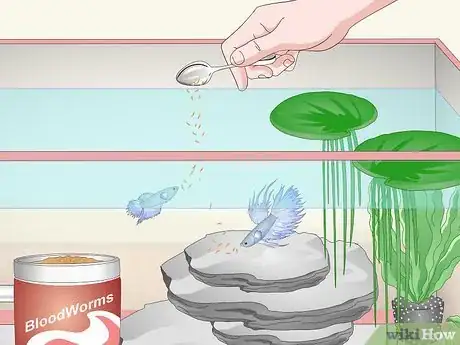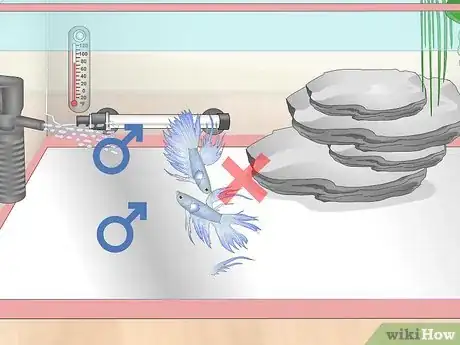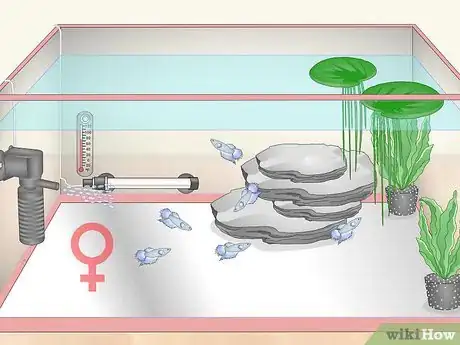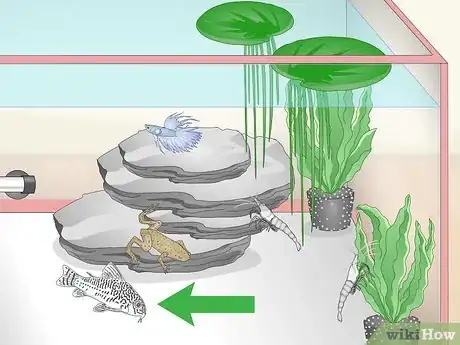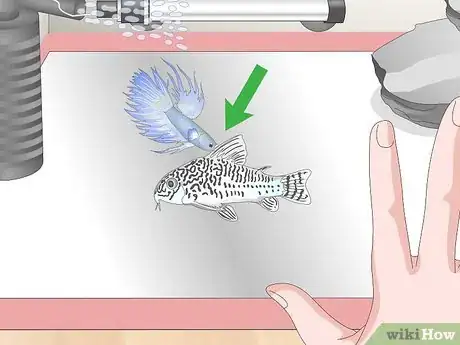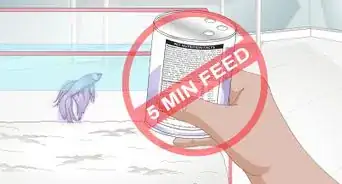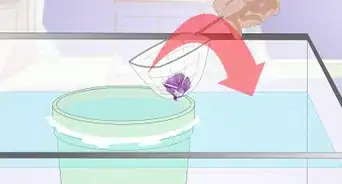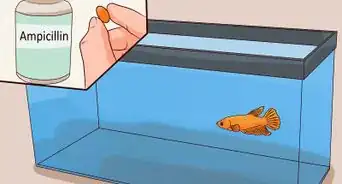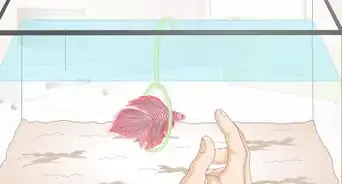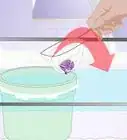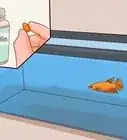This article was co-authored by Craig Morton and by wikiHow staff writer, Megaera Lorenz, PhD. Craig Morton is the CEO of Aquarium Doctor Inc. based in Huntington Beach California and servicing Orange County, Los Angeles County, and the Inland Empire. With over 30 years of aquarium experience, Craig specializes in creating custom aquarium designs along with aquarium installation, service, and maintenance.
There are 9 references cited in this article, which can be found at the bottom of the page.
This article has been viewed 70,197 times.
Crowntail bettas are one of several varieties of betta fish, known for their spectacular caudal fins, which can grow to 3 times the size of the fish’s body![1] These elegant fish need plenty of space and a clean aquarium environment to stay healthy and keep their delicate fins in good shape. Additionally, make sure you keep your crowntail betta on a balanced pellet or flake diet, which can be supplemented with live or freeze-dried foods. Although crowntail bettas are aggressive, they can coexist peacefully with some non-competitive tankmates.
Steps
Housing Your Crowntail Betta
-
1Get a tank that’s at least 10 gallons (38 L). Crowntail bettas need plenty of space so that they don’t damage their large, delicate fins by crashing into the aquarium walls, so plan on having at least 10 gallons (38 L) per betta.[2]
- If you plan to house your betta with other fish, you will need a bigger tank, though the exact size of your tank may depend on how much space the other fish needs. For example, if you add a blue gourami, the tank should be at least 20 gallons (76 L). This is the minimum tank size for a blue gourami, and should provide enough room for both the gourami and the betta (which has smaller size requirements).[3]
- Don’t try to keep your betta in a tiny fishbowl or vase. These environments are not spacious enough for your betta, and they will become dirty and polluted very quickly.
-
2Choose a tank with a fitted lid so your betta doesn’t accidentally jump out. However, make sure to leave at least 1–2 inches (2.5–5.1 cm) between the top of the water and the lid, since bettas like to come to the surface to gulp air.[4]
- Bettas are smart fish—you can train them to use their natural jumping behavior to perform tricks, like jumping through hoops!
Advertisement -
3Add a biological filter with low airflow to aerate your betta's tank. The addition of a biological filter will encourage the growth of beneficial bacteria, which help to maintain a healthy balance of ammonia and nitrates in the tank. However, make sure to keep the air flow gentle, since a strong current can potentially damage your crowntail betta's delicate fins.[5]
- Get advice from a fish specialist at your pet store about what kind of filter will work best with your betta’s tank.
-
4Keep the water temperature between 76–80 °F (24–27 °C). Use a submersible tank heater to keep your betta’s water consistently warm. These tropical fish thrive in warm water, and temperature fluctuations can be dangerous for them.[6]
- Check the wattage on your heater to make sure it is appropriate for the size of your tank. For example, a 50-watt heater is ideal for 5–10 gallons (19–38 L) tanks. For a larger tank, you would need a higher wattage (e.g., 100 watts for a 20 gallons (76 L) tank).
- Keep a thermometer in the tank so you can check that the heater is working correctly.
-
5Maintain a water pH of 6.4-7.0 and a hardness of 2-5. Water conditions such as pH level and carbonate hardness can affect your betta’s health.[7] Pick up an aquarium test kit at your local pet store or bring in a sample of your aquarium’s water for testing.
- If your water’s pH and hardness are not within a healthy range, ask a fish specialist at your pet store for advice on how to make adjustments.
- You can lower the pH of the water by adding organic materials such as driftwood or peat moss. If you need to raise the pH, you can do so by adding a small amount of baking soda to the water (typically 1 tsp (about 4.8 grams) per 5 gallons (19 L) of water).
- You will also need to use water that is dechlorinated and free of other chemical contaminants.
-
6Place the tank in a dimly lit area. Bettas in the wild live in dark, plant-filled water.[8] Too much light is not good for the fish and will also encourage the growth of algae in the tank. Keep the tank out of direct sunlight and choose dim, artificial light sources.[9]
- If you add an artificial light to the tank, put it on a timer so that it stays on for 12 hours during the day and switches off for 12 hours overnight.
-
7Put plants and hiding places in the tank to promote your betta's happiness. Feel free to be creative with your decorations, but aim for plant-dense water that simulates a crowntail betta's natural habitat. Add an assortment of live or artificial plants, smooth-sided aquarium rocks, and fish caves to create the perfect underwater habitat.[10]
- Make sure any plants or decorations you add are aquarium-safe.[11] They should also be free of points and sharp edges, since these can damage your betta’s fins.
- If you wish, you can also add a fine sand or gravel substrate to the bottom of the tank to give the environment a more natural look.
-
8Do a 10% water change every 2-3 days to keep your betta healthy. To replace the water in your aquarium, use a siphon to remove about 10% of the water from your betta’s tank, then replace the water you removed with clean, dechlorinated water. Try to use water that is roughly the same temperature and pH level as the water in the tank. Repeat every few days to keep the water clean![12]
- If your tank has a sand or gravel substrate, you will need to use a siphon-powered vacuum to clean the substrate once every 1-2 weeks.
- You can do water changes a little less frequently (e.g., once a week) if your tank is larger than 10 gallons (38 L). However, keep in mind that a tank with more fish in it will accumulate waste more quickly, so you may need to do more frequent changes if your betta has tank mates.
- A crowntail betta living in dirty water may be more prone to fin rot and other diseases.
Feeding Crowntail Bettas
-
1Feed your crowntail 2-3 small meals daily. Crowntail bettas have small stomachs, so they need to eat multiple small meals rather than have just one big feeding. You can feed your betta up to 3 times a day, but 2 feedings (in the morning and evening) are usually enough.[13]
- A good feeding schedule that you can try for a betta is 3 pellets in the morning, 3 pellets at night. [14]
- There are a variety of high-quality betta foods on the market, like Omega One Betta Buffet Pellets, New Life Spectrum Betta Pellets, and Hikari Betta Bio-Gold. You want to stay away from low quality foods like fish food made by Tetra and Aqueon. [15]
-
2Give your betta a variety of animal-based foods as snacks. Bettas are insectivorous fish that enjoy live and frozen foods. Good frozen options include bloodworms, black worms, mosquito larvae, brine shrimp, daphnia.You can also offer live foods such as white worms or wingless fruit flies. Freeze-dried foods should be fed only as a treat and not very often. [16]
- Try not to offer your betta too much of any of these treats during a feeding. For example, you might give it 2 or 3 freeze-dried bloodworms in one feeding.
Choosing Tank Mates for Your Betta
-
1House male bettas without other males in the tank. Male bettas are highly aggressive and competitive fish. If you put more than one crowntail male in the same tank, they will fight and feel stressed all the time. They may even fight each other to the death.[17]
- Even keeping 2 male bettas within sight of each other in separate tanks can cause stress. A male betta will become aggressive and go into display mode at the sight of another male, any similar brightly colored fish, or even his own reflection.
-
2Keep males and females together only for breeding. Male bettas are less aggressive with females than they are with other males. However, aggression is still enough of a problem that these fish do not coexist well together. Keep your males and females separate unless you plan to breed them.[18]
- Successfully breeding crowntail bettas is a complicated and expensive process, so don’t attempt it until you have a thorough understanding of what’s involved.
-
3Create a “sorority tank” if you want to keep several females. Female crowntail bettas are also aggressive, but they can coexist in a group with other females if they have enough space and places to hide. To minimize aggression, make sure the tank has plenty of plants and hiding spots like rocks with holes in them or hollow “betta logs.” Offer at least one hiding place for each fish in your sorority, so that they can stake out individual territories. Sororities should only be kept by experienced betta fish keepers. [19]
- Sororities work best with groups of at least 5 females. If you have a group of 5, keep them in a tank that is at least 20 gallons or bigger.[20]
- While female crowntail bettas are less spectacular in appearance than the males, they are still strikingly beautiful fish.
-
4Choose non-competitive tankmates if you want to house your crowntails with other species. Bettas can coexist relatively peacefully with some fish of other species. To find a good companion for your crowntail, look for a non-aggressive species that occupies a different niche within the aquarium environment from the betta. For example, you might choose a bottom-feeding fish, since bettas spend most of their time in the higher levels of the tank.[21]
- Some good companions for bettas include neon tetras, feeder guppies, ghost shrimp, cherry shrimp, and nerite snails. Cory catfish are also a good bet, and they have the added benefit of helping to keep the tank clean.[22]
- Keep in mind that male bettas will still feel threatened by any fish that is similar in size, behavior, and coloration to a male betta.
- Research the space and feeding requirements of any potential tankmates before introducing them, as their needs might be different from your betta’s.
-
5Watch your betta closely around other fish for signs of aggression. Even ideal tankmates are not necessarily immune to aggression from your crowntail betta. Whenever you introduce a new fish into a tank with your betta (or vice versa), watch carefully to make sure your fish are not fighting. Be prepared to separate the betta from the other fish if necessary.[23]
- When you first introduce your betta to a tank with other fish, keep the betta confined to a betta cup or other transparent enclosure for 30 minutes before releasing the it. Don’t release the betta into the tank if you see it doing a threat display (e.g., expanding its gills and “dancing” back and forth).
Expert Q&A
Did you know you can get premium answers for this article?
Unlock premium answers by supporting wikiHow
-
QuestionHow do you know if your betta is healthy?
 Craig MortonCraig Morton is the CEO of Aquarium Doctor Inc. based in Huntington Beach California and servicing Orange County, Los Angeles County, and the Inland Empire. With over 30 years of aquarium experience, Craig specializes in creating custom aquarium designs along with aquarium installation, service, and maintenance.
Craig MortonCraig Morton is the CEO of Aquarium Doctor Inc. based in Huntington Beach California and servicing Orange County, Los Angeles County, and the Inland Empire. With over 30 years of aquarium experience, Craig specializes in creating custom aquarium designs along with aquarium installation, service, and maintenance.
Aquarium Specialist, Aquarium Doctor Inc.
-
QuestionHow do I bond with my betta fish?
 Craig MortonCraig Morton is the CEO of Aquarium Doctor Inc. based in Huntington Beach California and servicing Orange County, Los Angeles County, and the Inland Empire. With over 30 years of aquarium experience, Craig specializes in creating custom aquarium designs along with aquarium installation, service, and maintenance.
Craig MortonCraig Morton is the CEO of Aquarium Doctor Inc. based in Huntington Beach California and servicing Orange County, Los Angeles County, and the Inland Empire. With over 30 years of aquarium experience, Craig specializes in creating custom aquarium designs along with aquarium installation, service, and maintenance.
Aquarium Specialist, Aquarium Doctor Inc.
-
QuestionMy bettas keep burying themselves and that kills them because they can't get oxygen. Why are they doing that?
 wikiHow Staff EditorThis answer was written by one of our trained team of researchers who validated it for accuracy and comprehensiveness.
wikiHow Staff EditorThis answer was written by one of our trained team of researchers who validated it for accuracy and comprehensiveness.
Staff Answer wikiHow Staff EditorStaff AnswerIt's possible that your bettas are trying to hide or build a comfortable sleeping place in the substrate. If you don't already have plants and other hiding places in your tank, try adding some. If the problem continues, try removing the sand or gravel--bettas can thrive in a tank with a bare bottom. Check to make sure there isn't too much light shining into your tank, since this can bother bettas and encourage hiding behaviors.
wikiHow Staff EditorStaff AnswerIt's possible that your bettas are trying to hide or build a comfortable sleeping place in the substrate. If you don't already have plants and other hiding places in your tank, try adding some. If the problem continues, try removing the sand or gravel--bettas can thrive in a tank with a bare bottom. Check to make sure there isn't too much light shining into your tank, since this can bother bettas and encourage hiding behaviors.
References
- ↑ https://www.fishkeepingworld.com/crowntail-betta/
- ↑ https://www.fishkeepingworld.com/crowntail-betta/#Habitat_and_Tank_Requirements
- ↑ https://japanesefightingfish.org/what-fish-can-live-with-bettas/
- ↑ https://kb.rspca.org.au/how-should-i-keep-and-care-for-siamese-fighting-fish_441.html
- ↑ https://kb.rspca.org.au/how-should-i-keep-and-care-for-siamese-fighting-fish_441.html
- ↑ https://www.fishkeepingworld.com/crowntail-betta/#Habitat_and_Tank_Requirements
- ↑ https://www.fishkeepingworld.com/crowntail-betta/#Habitat_and_Tank_Requirements
- ↑ https://www.fishkeepingworld.com/crowntail-betta/#Habitat_and_Tank_Requirements
- ↑ https://kb.rspca.org.au/how-should-i-keep-and-care-for-siamese-fighting-fish_441.html
- ↑ https://kb.rspca.org.au/how-should-i-keep-and-care-for-siamese-fighting-fish_441.html
- ↑ Craig Morton. Fish & Aquarium Specialist. Expert Interview. 21 July 2020.
- ↑ https://www.fishkeepingworld.com/crowntail-betta/#Habitat_and_Tank_Requirements
- ↑ https://www.fishkeepingworld.com/crowntail-betta/#Diet_and_Feeding_Requirements
- ↑ https://www.fishkeepingworld.com/crowntail-betta/#Diet_and_Feeding_Requirements
- ↑ Craig Morton. Fish & Aquarium Specialist. Expert Interview. 21 July 2020.
- ↑ https://www.fishkeepingworld.com/crowntail-betta/#Diet_and_Feeding_Requirements
- ↑ https://www.fishkeepingworld.com/crowntail-betta/#Compatibility_and_Tankmates
- ↑ https://www.fishkeepingworld.com/crowntail-betta/#Compatibility_and_Tankmates
- ↑ https://bettafish.org/betta-fish-tank-mates/
- ↑ https://bettafish.org/betta-fish-tank-mates/
- ↑ https://www.fishkeepingworld.com/crowntail-betta/#Compatibility_and_Tankmates
- ↑ https://bettafish.org/betta-fish-tank-mates/
- ↑ https://www.fishkeepingworld.com/crowntail-betta/#Compatibility_and_Tankmates
- ↑ https://japanesefightingfish.org/bubble-nests/
